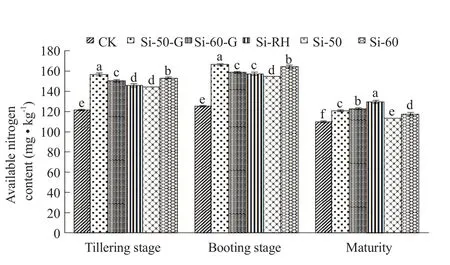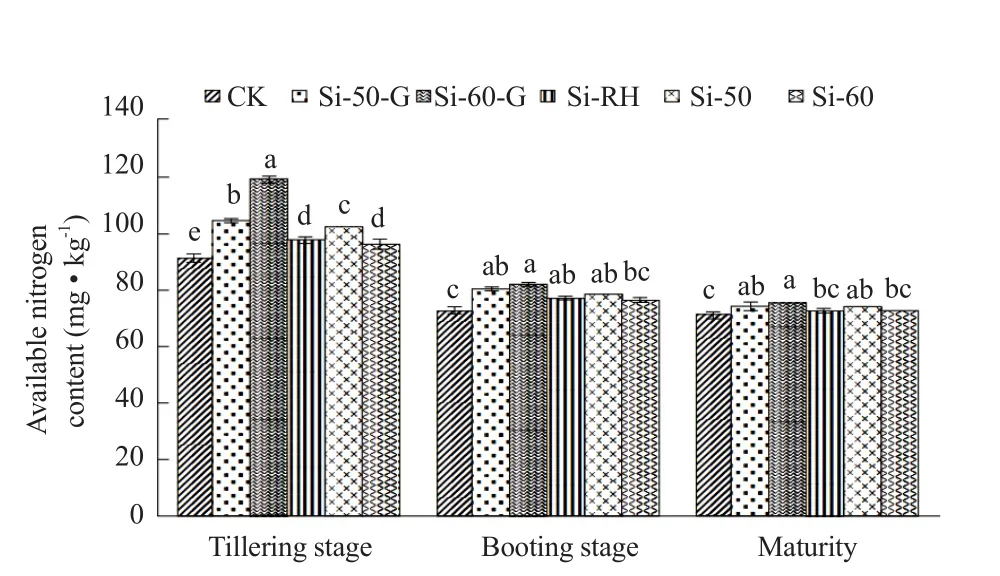Regulating Effect of Exogenous Silicon on Soil Fertility in Paddy Fields
2020-07-15SunYankunWangZhenhuaLiXuecongZhangXingwenRenHongyuandJingYu
Sun Yan-kun, Wang Zhen-hua, Li Xue-cong, Zhang Xing-wen, Ren Hong-yu*, and Jing Yu
1 College of Resources and Environmental Sciences, Northeast Agricultural University, Harbin 150030, China
2 College of Chemistry and Chemical Engineering, Harbin Institute of Technology, Harbin 150001, China
Abstract: In order to explore the effects of different silicon preparations on the soil fertility of paddy fields, a pot experiment with Dongnong 427 was carried on. Different types of silicon preparations, including Si-50-G, Si-60-G, Si-RH, Si-50 and Si-60, were sprayed on the leaves of rice at the tillering stage, and CK was set in the control stage. The contents of alkali nitrogen, available phosphorus, available potassium and available silicon in soil were determined in the tillering stage, booting stage and maturity stage of rice. The results showed that spraying different silicon preparations at the tillering stage could promote the activation and release of soil available nutrients in different degrees.
Key words: rice, silicon preparation, alkali nitrogen, available phosphorus, available potassium, effective silicon
Introduction
Rice is a typical silicon-loving crop. However, with the continuous increase of rice production in China, the supply capacity of silicon in soil has been declining in recent years. There are two kinds of silicon fertilizers that have been put into use in China: one is slag silicon fertilizer, sometimes there are heavy metal residues and inconvenient to transport; the other is mainly sodium silicate, potassium silicate and sodium metasilicate,which are fast-acting fertilizers. The concentration is very low, and the absorption effect on plants is not obvious. Therefore, the development and application of new silicon fertilizer are particularly important in China (Xuet al., 2014). This experiment was conducted to reveal the effects of different silicon preparations on the alkaline nitrogen, available phosphorus, available potassium and available silicon in rice soil, which could provide the basis of the scienti fic use of silicon fertilizer and optimize the fertilization management.
Materials and Methods
Plant materials and field experiment
The trial was conducted at the experimental station of the Horticultural College of Northeast Agricultural University in 2015. The pots used in potted plants were 30 cm in diameter and 25 cm in height. The test soil belonged to typical black soil, the content of soil organic matter content was 46.52 g · kg-1, the content of alkali nitrogen content was 144.90 mg · kg-1,the content of available phosphorus content was 51.39 mg · kg-1, the content of available potassium content was 182.00 mg · kg-1and the content of available silicon content was 149.99 mg · kg-1.
In this test, the silicon preparation used was provided by Harbin Institute of Technology. Among them, Si-50-G, using aminopropyl-triethoxysilane as raw materials, was prepared into a silicon preparation containing amino groups by the sol-gel method; Si-60-G, using 3-glycidyloxypropyl-trimethoxysilane as raw materials, was prepared by sol-gel method containing epoxy groups; Si-RH was a rice husk ash obtained by sintering a rice shell at 500℃, and the obtained powder material was ball milled by a ball mill; Si-50 was aminopropyl-triethoxysilane; Si-60 was 3-glycidoxypropyl-trimethoxysilane.
Test design
The trial was carried out on May 26, 2015 and harvested on September 30. In the rice tillering stage, silicon preparations were sprayed on the rice leaves, and then the content of available nutrients in rice soil was determined. There were six treatments with triplicate in this experiment. The five silicon preparations were Si-50-G, Si-60-G, Si-RH, Si-50,Si-60 and CK (spraying equal amount of distilled water), respectively. Sample size of experiment is 54.In the experiment, there were five transplanting holes in each pot, three plants in each hole, and the treatment of fertilization and irrigation in each pot kept the same. Before the transplanting, the base fertilizer was applied. Each pot was applied with 3.04 g of urea, 1.78 g of diammonium phosphate and 1.98 g of potassium sulfate. The N, P and K fertilizers were all applied to the potted water as base fertilizer. In the rice tillering stage (spraying began on June 9), it was sprayed once every three days, and sprayed three times, each time until the rice leaves were covered with water droplets.
Sampling and measurement methods
The sampling date was July 2 (the tillering period),July 31 (the booting stage) and September 30 (the mature period), respectively. Grind the soil with a mortar and pass through 0.50 mm and 1 mm sieves,respectively.
The soil alkaline nitrogen content was determined by alkali diffusion method; the available phosphorus content was extracted with 0.5 mol · L-1NaHCO3molybdenum blue colorimetric method; the available potassium content was determined by flame photometry; the available silicon content was extracted with 0.025 mol · L-1citric acid and the silicon molybdenum blue colorimetric method.
Data statistics and analysis methods
Statistical analysis was performed SPSS 19.0 software and EXCLE 2013 software, and the significance test was performed using Duncan's new complex range test.
Results
Effects of different silicon preparations on soil available nutrients
Fig. 1 showed that different silicon preparations could promote the increase of alkali nitrogen content in the tillering, booting and maturity stages of rice.In the tillering stage, Si-50-G treatment was the highest, which was higher than CK by 28.97%.Followed by Si-60 and Si-60-G, the two treatments were significantly higher than CK by 26.16%and 23.74%, respectively. The content of alkaline nitrogen in the soil at the booting stage was at a high level, and Si-50-G was the highest, which was significantly higher than that of CK by 32.73%.The content of alkali nitrogen in the mature period was lower than that in the tillering and booting stages. The content of alkali nitrogen in Si-RH treatment was the highest, and the content was 129.87 mg · kg-1, which was significantly higher than that of CK by 17.62%.The content of alkali nitrogen in Si-60-G, Si-50-G,Si-60 and Si-50 was also significantly higher than that of CK, which increased by 10.65%, 8.92%, 5.87% and 2.37%, respectively.
Fig. 2 showed that the available phosphorus content in the soil treated with different silicon preparations during the tillering period was significantly higher than that of CK. The highest Si-60-G was 119.19 mg · kg-1, followed by Si-50-G and Si-50. The difference among the three treatments was significantly higher than that of CK by 30.47%, 14.42% and 11.84%,respectively. The soil available phosphorus content at the booting stage was significantly higher than that of CK, which was 12.04%, 9.92% and 7.16% higher than that of CK. Si-60-G, Si-50-G and Si-50 were significantly higher than CK, which increased by 5.73%, 4.04% and 3.88%, respectively. Overall, the available phosphorus content in the soil decreased with the growth periods of rice, i.e., tillering stage>booting stage>maturity stage.

Fig. 1 Changes of soil alkaline nitrogen content under different silicon preparations

Fig. 2 Changes of soil available phosphorus content under different silicon preparations
It could be seen from Fig. 3 that the soil available potassium contents of Si-50-G, Si-60-G, Si-RH,Si-50 and Si-60 were significantly higher than those of CK by 56.78%, 49.72%, 25.25%, 58.88 % and 53.26%, respectively. The highest available potassium content in Si-60 soil at the booting stage reached 472.80 mg · kg-1, followed by Si-50 and Si-60-G,which was significantly higher than that of CK by 58.78%, 57.17% and 56.81%, respectively; however,the difference among Si-60, Si-50 and Si-60-G was not significant. Si-50-G and Si-RH were significantly higher than CK by 50.05% and 29.51%, respectively.The treatments in the maturity period were signi fi-cantly higher than CK. Among them, the content of Si-60-G was the highest, significantly higher than that of CK by 88.30%. The second was Si-60. After spraying different silicon preparations in the tillering stage, the content of available potassium in soil decreased with the growth process of rice. Among them, Si-60 and Si-50 had better effects on increasing soil available potassium.

Fig. 3 Changes of soil available potassium content under different silicon preparations
Effects of different silicon preparations on soil available silicon content
Fig. 4 showed that the soil available silicon content after treatments with different silicon preparations at the tillering stage was significantly higher than that of CK, following this order: Si-60-G, Si-60, Si-50, Si-50-G and Si-RH, which increased by 11.06%, 7.43%,5.23%, 4.52% and 3.33% than that of CK, respectively.The highest effective silicon content of Si-60-G soil was 232.29 mg · kg-1, and the lowest available silicon content of Si-60 was 217.44 mg · kg-1. At the maturity stage, the available silicon content of Si-60-G, Si-60 and Si-RH soils was significantly higher than that of CK, which increased by 39.15%, 38.03% and 25.21%,respectively.

Fig. 4 Changes of soil available silicon content under different silicon preparations
Discussion
Oxygen secretion from rice roots significantly increased the redox status of rhizosphere soil and increased soil enzyme activity and indirectly increased the mineralization efficiency of organic nitrogen(Li and Wang, 2013). The chemical behavior of phosphorus in paddy soil was easily changed under flooding conditions. Different silicon preparations could promote the growth of rice roots and increase the number of intracellular mitochondria, which also increased the respiration rate of roots and enhanced the transport capacity of oxygen to the underground(Ma and Takahashi, 1990). These could change soil pH and enhance oxygen secretion in rice roots, thereby reducing soil adsorption of phosphorus and increasing phosphorus desorption capacity in rhizosphere soil. In the paddy field under the flooding turntable, a large amount of soluble Fe2+and Mn2+in the soil solution could replace the exchangeable potassium from the clay complex, so that the potassium remained in a high level (Dobermannet al., 1996). Jianget al. (2002)showed that oxalic acid, tartaric acid, citric acid and malic acid could significantly promote the release of potassium in soil. The silicon preparation increased the oxygen secretion of rice roots, and the changes of pH and organic acid secretion promote the conversion of slow-acting potassium to available potassium. Zhanget al.(2003) and Hou (2010) found that the silicon uptake at different growth stages of rice was tillering stageheading stage>heading stage-mature stage>seedling stage-tillering stage, which was consistent with the results of this test. Different forms of silicon were in a state of dynamic equilibrium. Silicon preparations could improve the root activities of rice plants, which might change pH of the soil and thus affected the conversion of amorphous silicon to available silicon.
Conclusions
In summary, at the tillering stage of rice, spraying different types of silicon preparations (Si-50-G, Si-60-G, Si-RH, Si-50 and Si-60) could promote the soil nutrients in different degrees.
杂志排行
Journal of Northeast Agricultural University(English Edition)的其它文章
- Regeneration Function Analysis of GmESR1 in Transgenic Soybean
- Effect of Salt Stress on Nitrogen Assimilation of Functional Leaves and Root System of Rice in Cold Region
- Effects of Straw Returning with Different Tillage Patterns on Corn Yield and Nitrogen Utilization
- Effects of Rare Earth Lanthanum and Cerium on Antioxidant Enzyme Activities in Soybean Leaves
- Uptake of B, Co and Ni by Plants from Oil Contaminated Soil Capped with Peat
- Anti-tumor Effect of Newcastle Disease Virus Expressing IL-2 in Lung Cancer Model
